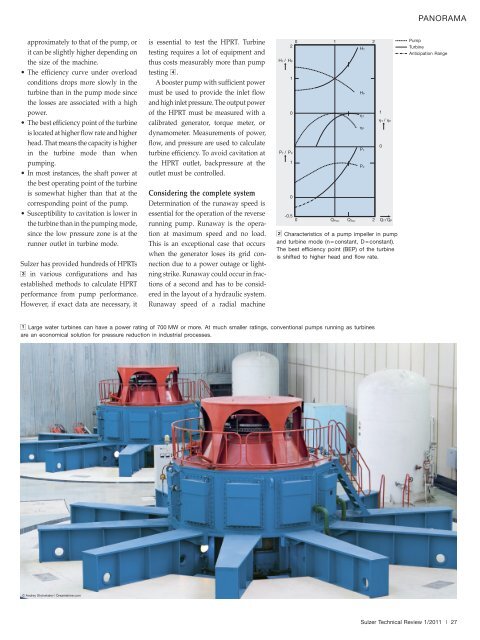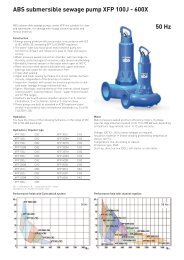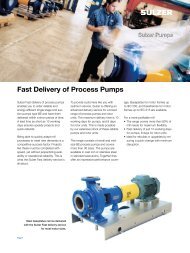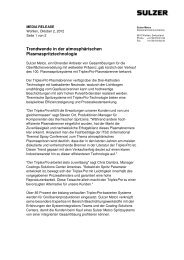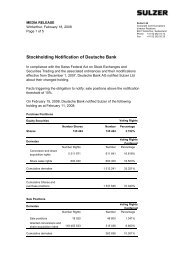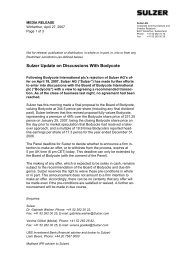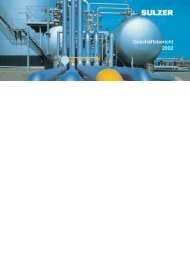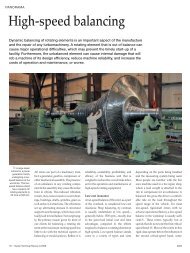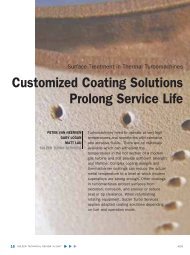Testing and quality
Testing and quality
Testing and quality
You also want an ePaper? Increase the reach of your titles
YUMPU automatically turns print PDFs into web optimized ePapers that Google loves.
approximately to that of the pump, or<br />
it can be slightly higher depending on<br />
the size of the machine.<br />
• The efficiency curve under overload<br />
conditions drops more slowly in the<br />
turbine than in the pump mode since<br />
the losses are associated with a high<br />
power.<br />
• The best efficiency point of the turbine<br />
is located at higher flow rate <strong>and</strong> higher<br />
head. That means the capacity is higher<br />
in the turbine mode than when<br />
pumping.<br />
• In most instances, the shaft power at<br />
the best operating point of the turbine<br />
is somewhat higher than that at the<br />
corresponding point of the pump.<br />
• Susceptibility to cavitation is lower in<br />
the turbine than in the pumping mode,<br />
since the low pressure zone is at the<br />
runner outlet in turbine mode.<br />
Sulzer has provided hundreds of HPRTs<br />
3 in various configurations <strong>and</strong> has<br />
established methods to calculate HPRT<br />
performance from pump performance.<br />
However, if exact data are necessary, it<br />
is essential to test the HPRT. Turbine<br />
testing requires a lot of equipment <strong>and</strong><br />
thus costs measurably more than pump<br />
testing 4 .<br />
A booster pump with sufficient power<br />
must be used to provide the inlet flow<br />
<strong>and</strong> high inlet pressure. The output power<br />
of the HPRT must be measured with a<br />
calibrated generator, torque meter, or<br />
dynamometer. Measurements of power,<br />
flow, <strong>and</strong> pressure are used to calculate<br />
turbine efficiency. To avoid cavitation at<br />
the HPRT outlet, backpressure at the<br />
outlet must be controlled.<br />
Considering the complete system<br />
Determination of the runaway speed is<br />
essential for the operation of the reverse<br />
running pump. Runaway is the operation<br />
at maximum speed <strong>and</strong> no load.<br />
This is an exceptional case that occurs<br />
when the generator loses its grid connection<br />
due to a power outage or lightning<br />
strike. Runaway could occur in fractions<br />
of a second <strong>and</strong> has to be considered<br />
in the layout of a hydraulic system.<br />
Runaway speed of a radial machine<br />
0 1 2<br />
2<br />
0 2<br />
QPop: QTop:<br />
2 Characteristics of a pump impeller in pump<br />
<strong>and</strong> turbine mode (n = constant, D = constant).<br />
The best efficiency point (BEP) of the turbine<br />
is shifted to higher head <strong>and</strong> flow rate.<br />
1 Large water turbines can have a power rating of 700 MW or more. At much smaller ratings, conventional pumps running as turbines<br />
are an economical solution for pressure reduction in industrial processes.<br />
© Andrey Shchekalev | Dreamstime.com<br />
HT / HP<br />
1<br />
0<br />
PT / PP<br />
1<br />
0<br />
-0.5<br />
HT<br />
HP<br />
ηT<br />
ηP<br />
PT<br />
PP<br />
1<br />
ηT / ηP<br />
0<br />
QT/QP<br />
PANORAMA<br />
Pump<br />
Turbine<br />
Anticipation Range<br />
Sulzer Technical Review 1/2011 |<br />
27


